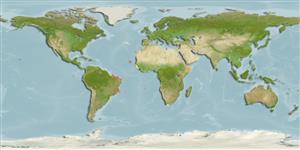Actinopterygii (ray-finned fishes) >
Perciformes (Perch-likes) >
Scaridae (Parrotfishes) > Sparisomatinae
Etymology: Sparisoma: Latin, sparus = a fish with a golden head + Greek, soma = body (Ref. 45335).
Environment / Climate / Range
Ecology
Marine; reef-associated; depth range 1 - 30 m (Ref. 40827). Tropical, preferred ?
Southwest Atlantic: endemic to Brazil and its oceanic islands.
Size / Weight / Age
Maturity: Lm ? range ? - ? cm
Max length : 39.0 cm SL male/unsexed; (Ref. 40827)
Short description
Morphology | Morphometrics
Similar to S. viride but distinguished by the distinctive color pattern of the TP specimens; S. amplum is without yellow area on caudal peduncle ('stoplight') and without yellow spot at the angle of opercle (Ref. 40827).
Occurs in oceanic islands, dwelling mainly in shallow and turbulent areas on coral, algal and rocky reefs. Occurs in smaller groups in deeper habitats (Ref. 40827).
Life cycle and mating behavior
Maturity | Reproduction | Spawning | Eggs | Fecundity | Larvae
Moura, R.L., J.L. de Figueiredo and I. Sazima, 2001. A new parrotfish (Scaridae) from Brazil, and revalidation of Sparisoma amplum (Ranzani, 1842), Sparisoma frondosum (Agassiz, 1831), Sparisoma axillare (Steindachner, 1878) and Scarus trispinosus Valenciennes, 1840. Bull. Mar. Sci. 68(3):505-524. (Ref. 40827)
IUCN Red List Status (Ref. 115185)
CITES (Ref. 94142)
Not Evaluated
Threat to humans
Harmless
Human uses
More information
Common namesSynonymsMetabolismPredatorsEcotoxicologyReproductionMaturitySpawningFecundityEggsEgg development
ReferencesAquacultureAquaculture profileStrainsGeneticsAllele frequenciesHeritabilityDiseasesProcessingMass conversion
Tools
Special reports
Download XML
Internet sources
Estimates of some properties based on models
Phylogenetic diversity index (Ref.
82805): PD
50 = 0.5000 [Uniqueness, from 0.5 = low to 2.0 = high].
Bayesian length-weight: a=0.01622 (0.00952 - 0.02762), b=3.13 (2.99 - 3.27), in cm Total Length, based on LWR estimates for this species & Genus-body shape (Ref.
93245).
Trophic Level (Ref.
69278): 2.0 ±0.1 se; Based on size and trophs of closest relatives
Resilience (Ref.
69278): Medium, minimum population doubling time 1.4 - 4.4 years (Preliminary K or Fecundity.).
Vulnerability (Ref.
59153): Moderate vulnerability (39 of 100) .
